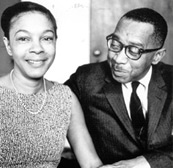
Credit: The U.S. National Archives and Records Administration, William Thomas, 1950
Returning World War II veterans spurred a population and housing boom driven in part by benefits from the Gl bill. The economic demands of the post-war boom and the burgeoning Civil Rights movement led to conflicts over discrimination in housing, jobs and education. The Federal Housing Administration, which instituted policies that reinforced patterns of segregation, routinely denied low-interest loans to non-whites. The experience of fighting for freedom in Europe and then returning to a country where discrimination and opportunities were limited fostered discontent for returning black Gs. The legacy of post-war economic discrimination contributed to the wealth gap between whites and non-whites that we see today. One of the most important factors that contributed to the wealth gap was the federal housing policy. This policy endorsed redlining and discrimination in sales, financing and homeowners insurance, is reflected in the unequal rates of home ownership even today.
- In August 1955, Emmett Till, a fourteen year-old from Chicago, visited relatives in Mississippi. He and several other boys stopped at a local grocery store for some candy after a long day of picking cotton. While at the store, Till allegedly whistled at a white grocery store owner’s wife. A few days later, after Roy Bryant, the store owner, returned to town and learned of the event, Bryant and his half-brother J.W. Milam made plans to teach the boy a lesson. Bryant and Milam kidnapped Till, and then brutally beat, mutilated and shot him before dropping him in the Tallahatchie River. While Bryant and Milam were arrested for the murder, the all-white Mississippi jury took just over an hour to acquit the two. Mamie Till Bradley, Till’s mother, held an open casket funeral in Chicago so mourners could see how her son had been mutilated. Even so, Bryant and Milam later boasted about the murder in a Look magazine interview, since double jeopardy protected them from retrial.
- In December 1955, Rosa Parks, a member of the NAACP, made civil rights history when she refused to relinquish her seat to a white passenger on a public bus. After she was arrested, the Montgomery black community launched a bus boycott, led by Reverend Martin Luther King, Jr., the recently elected president of the Montgomery Improvement Association. The boycott ended just over one year later on Dec. 21, 1956 when the city buses were finally desegregated.
- E. Franklin Frazier published Black Bourgeoisie in 1957, a socioeconomic study of the African American color caste system in the U.S.
- In 1957, three years after the Brown decision, nine African American students desegregated Little Rock High School. President Dwight David Eisenhower forced to call in National Guard troops to protect the nine black students from violent protests.

Credit: Kenneth and Mamie Phipps Clark, with permission of the University Archives, Columbia University in
the City of New York
“A racist system inevitably destroys and damages human beings; it brutalizes and dehumanizes them, blacks and whites alike.”
– Kenneth Clark
Sociologist Kenneth Clark was instrumental in the Brown V. Board of Education school desegregation decision when he testified about the detrimental effects of racism on African-American children based on research he and his wife Mamie (shown above) conducted in the 1940s. Clark became famous for the “doll” experiments, in which children were presented with the choice of black doll and a white doll. In virtually every case, the white doll was selected even by the black children, who Clark theorized had internalized racial prejudice.




